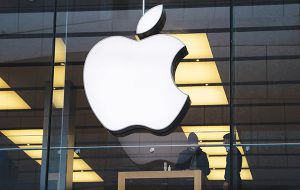There’s no doubt what July 18’s biggest market news was in New York. Apple Inc stock fell more than 2% in its worst session in almost three weeks after Bloomberg revealed the company’s plans to slow hiring and spending to cope with a potential economic downturn. The news, shortly after midday, sparked an immediate tumble.
Until now, shares of the iPhone-maker had fallen roughly 17% for the year, in step with the broader market rout. The announcement undercut the market, with other big “FANG†internet platforms such as Alphabet Inc and Microsoft Corp also falling. The tech stalwart had been among the companies that beat Wall Street expectations throughout the pandemic, and had come to be seen as a defensive stock, so any negative news was bound to hurt sentiment across the market.
The development was particularly unwelcome as it came just as the tech sector appeared ready to rally. The Nasdaq 100, down 27% for the year so far, had briefly managed to get above its 50-day moving average, suggesting that the relentless downward trend was over — but the index failed to stay there, thanks in large part to Apple.
There have been hopes that valuation is at last looking favourable for the tech sector once more — although this gets a little harder to sustain on closer examination. The spread between the prospective earnings multiples of the S&P 500 Information Technology Sector and the benchmark S&P 500 started this year at the highest it had been since 2004. A “healthy correction†was in order, and what looks like some seriously unhealthy speculative excess has now been wrung out of the market. However, it’s worth noting that from the Great Financial Crisis through to about 2018, tech basically traded at the same multiple as the rest of the market.
There is a similar message from the tech index’s P/E ratio judged in its own right. It has slipped to 20.6, having peaked above 30 in the first year of the pandemic. But 20 appears to be the level at which it hit a plateau in 2017 and 2018 — again while it looks like the excess has been blown off the top, there’s no particular reason to think that the multiple can rebound.
Investors will get more clarity when more tech heavyweights report earnings following mixed results from major banks. Netflix Inc, savagely punished for disappointing results so far this year, was expected to kick off the FANG stocks on Tuesday. This is the season for all companies to get bad news off their chests, so the chances of a durable rebound should be much stronger once investors believe they know the worst.
Nicholas Colas, co-founder of DataTrek Research, would “prefer to get bullish†on US large-cap tech once he sees second-quarter earnings season, which will include third-quarter guidance. This, even as Wall Street’s forecast still remains relatively optimistic. “Even still, the return math says the Nasdaq is pretty washed out here on a relative basis,†he said.
Still, if earnings of tech companies prove profitable, or traders can be convinced that the worst news is known, it may solidify its status as the new defensive play, at least for now.
Colas is not alone in suggesting that the conditions for a bottom are not in place, despite the recent signs of life in the tech sector. Tom Essaye, a former Merrill Lynch trader who founded The Sevens Report, continues to suggest that some broader macro landmarks need to be passed before the market can make a durable bottom.
—Bloomberg
John Authers is a senior editor for markets and Bloomberg Opinion columnist. A former chief markets commentator and editor of the Lex column at the Financial Times,
he is author of “The Fearful Rise of Marketsâ€
 The Gulf Time Newspaper One of the finest business newspapers in the UAE brought to you by our professional writers and editors.
The Gulf Time Newspaper One of the finest business newspapers in the UAE brought to you by our professional writers and editors.

